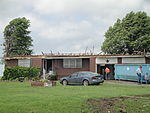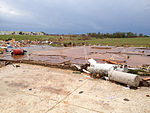Enhanced Fujita Scale
Enhanced Fujita Scale
The Enhanced Fujita scale (or abbreviated as EF-Scale) rates the intensity of tornadoes in some countries, including the United States and Canada, based on the damage they cause.
The Enhanced Fujita scale replaced the decommissioned Fujita scale that was introduced in 1971 by Ted Fujita. Operational use began in the United States on February 1, 2007, followed by Canada on April 1, 2013.
The seven categories for the EF scale are listed below, in order of increasing intensity. Although the wind speeds and photographic damage examples are updated, the damage descriptions given are based on those from the Fujita scale, which are more or less still accurate. However, for the actual EF scale in practice, damage indicators (the type of structure which has been damaged) are predominantly used in determining the tornado intensity.[8]
| Scale | Wind speed estimate[9] | Frequency | Potential damage | Example of damage | |
| mph | km/h | ||||
| EFU | N/A | N/A | 2.43% | No surveyable damage.
Intensity cannot be determined due to a lack of information. This rating applies to tornadoes that traverse areas with no damage indicators, cause damage in an area that cannot be accessed by a survey, or cause damage which cannot be differentiated from that of another tornado.[5] |
N/A |
| EF0 | 65–85 | 105–137 | 53.29% | Minor damage.
Peels surface off some roofs; some damage to gutters or siding; branches broken off trees; shallow-rooted trees pushed over. Until the EFU classification was added, confirmed tornadoes with no reported damage (i.e., those that remain in open fields) had also been rated EF0. While permanent buildings generally suffer only minor damage, unprotected mobile homes or trailers may sustain moderate to serious damage.[10] |
 |
| EF1 | 86–110 | 138–177 | 33.03% | Moderate damage.
Roofs severely stripped; mobile homes overturned or badly damaged; loss of exterior doors; windows and other glass broken. |
 |
| EF2 | 111–135 | 178–217 | 8.52% | Considerable damage.
Roofs torn off from well-constructed houses; foundations of frame homes shifted; mobile homes completely destroyed; large trees snapped or uprooted; light-object missiles generated; cars lifted off ground. |
 |
| EF3 | 136–165 | 218–266 | 2.20% | Severe damage.
Entire stories of well-constructed houses destroyed; severe damage to large buildings such as shopping malls; trains overturned; trees debarked; heavy cars lifted off the ground and thrown; structures with weak foundations are badly damaged. |
 |
| EF4 | 166–200 | 267–322 | 0.47% | Devastating damage.
Well-constructed and whole frame houses completely leveled; some frame homes may be swept away; cars and other large objects thrown and small missiles generated. |
 |
| EF5 | >200 | >322 | 0.06% | Incredible damage.
Well-built frame houses destroyed with foundations swept clean of debris; steel-reinforced concrete structures are critically damaged; tall buildings collapse or have severe structural deformations; cars, trucks, and trains can be thrown approximately 1 mile (1.6 km). |
 |

